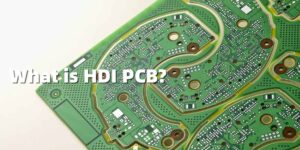HDI stands for High Density Interconnect. HDI PCBs are defined as boards with a higher density of wiring per unit area than traditional circuit boards. They feature thinner lines and pitches, smaller via and capture pads, and higher density of connection pads than traditional PCB technology. HDI PCBs are used to reduce size and weight, as well as to enhance the electrical performance of devices. HDI PCBs are manufactured with Microvia and buried vias and sequentially laminated with insulation and conductor wiring to achieve higher wiring density. HDI PCBs are a great alternative to high layer count and expensive standard laminates or sequential laminates.
With respect to the electrical requirements of high-speed signals, PCBs must have certain AC characteristics such as impedance control, high frequency transmission capability and reduction of unwanted emissions. The construction of ribbon and microstrip lines requires a multi-layer design. To mitigate the quality of signal transmission problems, insulating materials with low dielectric coefficient and low attenuation ratio are used. Due to miniaturization and arraying of electronic components, the density of PCBs must be increased. With the result of ball grid arrays, chip scale packaging and direct chip attachment assembly methods, PCBs have an unprecedented high density. A hole with a diameter of less than 150um is called Microvia. it can improve assembly efficiency and space utilization, etc. It is also necessary for miniaturization of electronic products.
PCBs with this structure have many different names. For example, because program production is in the constructive mode of a sequence, it is called SBU (sequence building process) in the European and American industries. In the Japanese industry it is called MVP (Microvia Process) because the holes in such products are much smaller than previous products. It is also known as BUM (Build Up Multilayer Board) because the conventional multilayer is called MLB (Multilayer Board). To avoid confusion, the IPC Printed Circuit Association proposed the name HDI (High Density Interconnect Technology), but it does not reflect the characteristics of the board. Therefore, most of the PCB industry defines such products as HDI PCBs.
HDI PCBs offer many advantages such as small form factor, high speed and high frequency. It is a key component of personal computers, portable computers, cell phones, and personal digital assistants. Currently, in addition to cell phones, HDI PCBs are also widely used in a variety of other consumer products such as game consoles and MP3 players. In addition, HDI PCBs are expected to be trending in notebook PCs since 2006.














